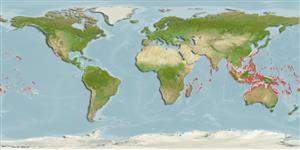Teleostei (teleosts) >
Ovalentaria/misc (Various families in series Ovalentaria) >
Pomacentridae (Damselfishes) > Microspathodontinae
Etymology: Plectroglyphidodon: Greek,plektron = anything to strike with, spur + Greek, glyphis = carved + Greek, odous = teeth (Ref. 45335).
Environment: milieu / climate zone / depth range / distribution range
Ecology
Marine; reef-associated; non-migratory; depth range 0 - 20 m (Ref. 128797). Tropical; 30°N - 30°S
Indo-Pacific: East Africa to the Line and Tuamoto islands, north to Japan, south to Australia.
Size / Weight / Age
Maturity: Lm ? range ? - ? cm
Max length : 11.6 cm TL male/unsexed; (Ref. 124696); max. published weight: 35.62 g (Ref. 124696)
Adults inhabit coral-rich and surge areas of clear lagoon and seaward reefs (Ref. 1602). Commonly associated with Pocillopora or Acropora corals (Ref. 1602). Feed on filamentous algae, small benthic invertebrates, and occasionally small fishes (Ref. 1602). Oviparous, distinct pairing during breeding (Ref. 205). Eggs are demersal and adhere to the substrate (Ref. 205). Males guard and aerate the eggs (Ref. 205). Diurnal species (Ref. 54980; 113699).
Life cycle and mating behavior
Maturities | Reproduction | Spawnings | Egg(s) | Fecundities | Larvae
Oviparous, distinct pairing during breeding (Ref. 205). Eggs are demersal and adhere to the substrate (Ref. 205). Males guard and aerate the eggs (Ref. 205).
Allen, G.R., 1991. Damselfishes of the world. Mergus Publishers, Melle, Germany. 271 p. (Ref. 7247)
IUCN Red List Status (Ref. 130435)
Threat to humans
Harmless
Human uses
Fisheries: minor commercial; aquarium: commercial
Tools
Special reports
Download XML
Internet sources
Estimates based on models
Preferred temperature (Ref.
123201): 25 - 29.3, mean 28.3 °C (based on 2789 cells).
Phylogenetic diversity index (Ref.
82804): PD
50 = 0.5010 [Uniqueness, from 0.5 = low to 2.0 = high].
Bayesian length-weight: a=0.01995 (0.01171 - 0.03398), b=2.98 (2.83 - 3.13), in cm total length, based on LWR estimates for this species & (Sub)family-body (Ref.
93245).
Trophic level (Ref.
69278): 3.7 ±0.3 se; based on diet studies.
Resilience (Ref.
120179): High, minimum population doubling time less than 15 months (Preliminary K or Fecundity.).
Fishing Vulnerability (Ref.
59153): Low vulnerability (10 of 100).
Nutrients (Ref.
124155): Calcium = 99.9 [49.4, 166.6] mg/100g; Iron = 0.679 [0.390, 1.141] mg/100g; Protein = 18.6 [17.4, 19.7] %; Omega3 = 0.119 [0.069, 0.199] g/100g; Selenium = 19.1 [10.3, 38.1] μg/100g; VitaminA = 119 [35, 402] μg/100g; Zinc = 1.48 [0.97, 2.16] mg/100g (wet weight);
